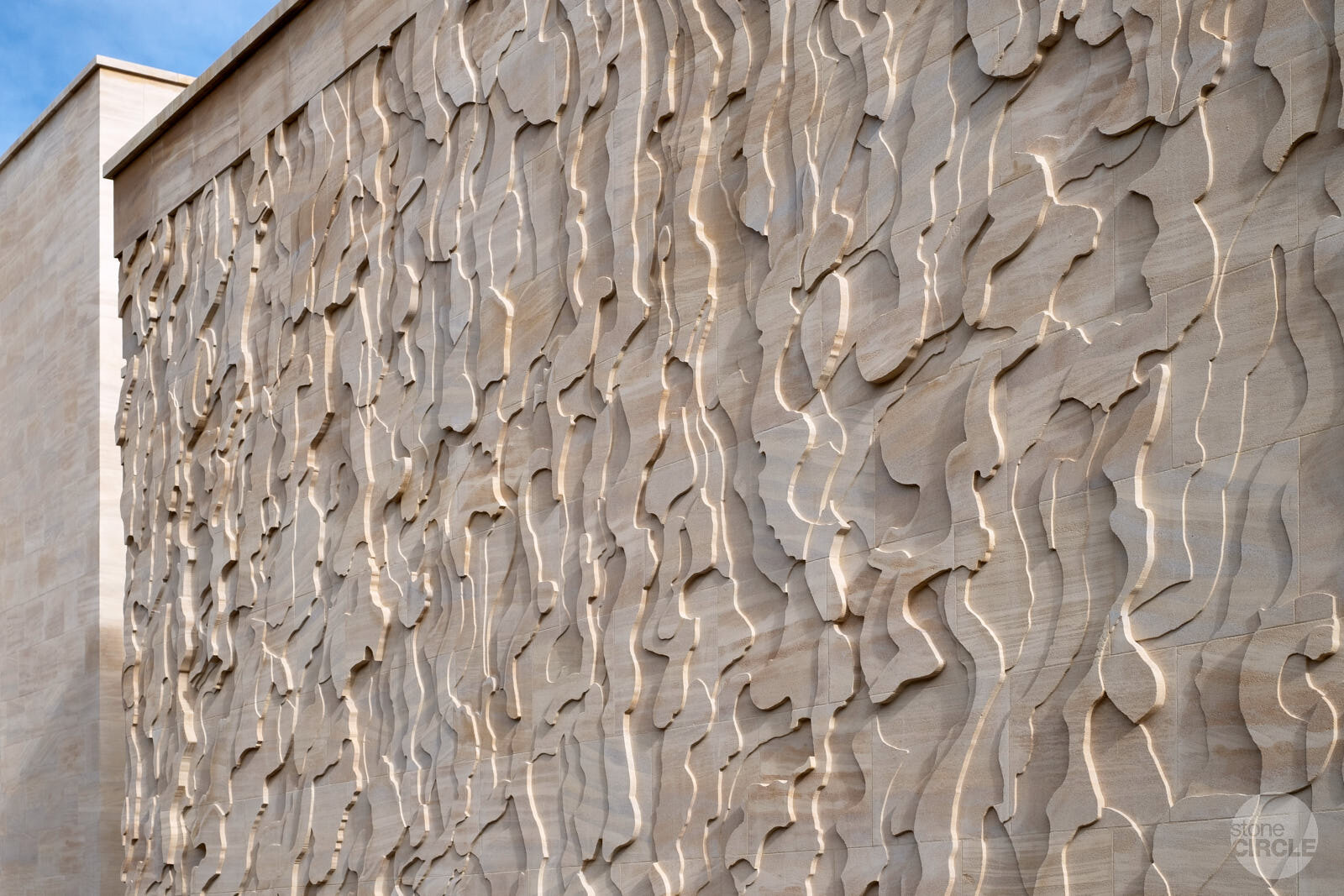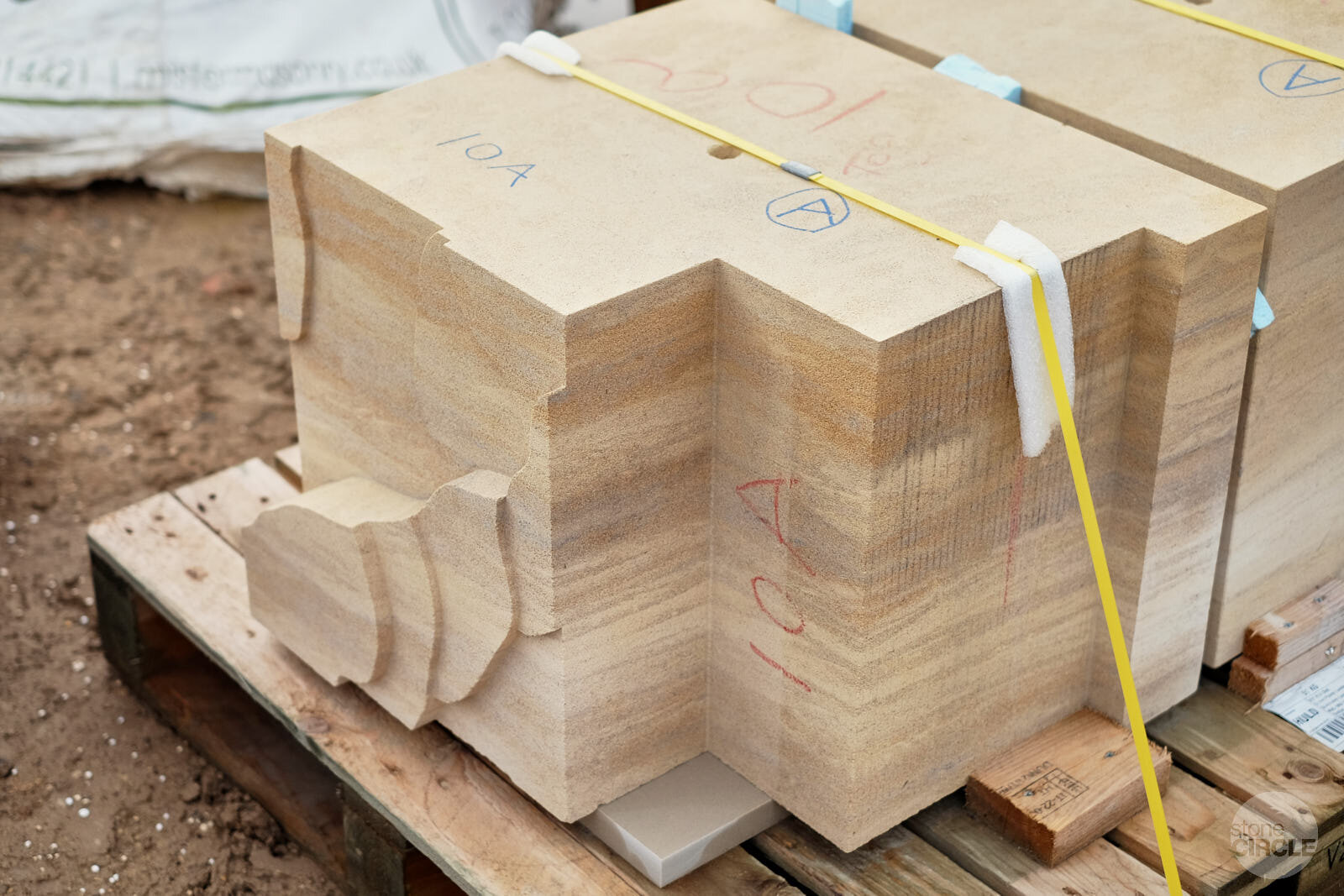a stone drawing for a college library
Susanna Heron’s Stone Drawing
St John’s College, Oxford
St John’s College Oxford appointed Susanna Heron in 2014 to prepare a work of art for a new Library and Study Centre at the College with Wright & Wright Architects, since shortlisted for the RIBA Regional Awards South 2020. She turned to stoneCIRCLE with whom she had previously worked to help manufacture the piece.
The building won an award in the Stone Federations Natural Stone Awards, more details are given here.
The finished artwork installed in the library and study centre (© Susanna Heron, no reproduction without permission)
The resulting artwork, called Stone Drawing, is a shallow carved stone relief in Clipsham limestone, the same stone used in the old university buildings of Oxford, sourced from Stamford Stone who are the sole suppliers of Clipsham stone. The work is situated on both external and internal faces of the west side of a new Library and Study Centre for St John’s College Oxford and was completed in 2018. The original 17th century St John’s College library is housed within Canterbury Quadrangle, one of the greatest Baroque architectural quadrangles in Oxford and the Study Centre adjoins it.
creating the work of art
At the beginning of the commission Susanna visited the quarry where the stone was sourced to give her a better understanding of the formation of the stone in the landscape, and a feeling for the way it was likely to behave during cutting and over time. Samples were made with the stonemasons at stoneCIRCLE to establish depth and finish.
Susanna has described her working process as follows:
"In the studio I think about the work by making drawings. These sketches are quite abstract, enabling me to get a pace and sense of scale so that when I am drawing it is in the knowledge of the actual size. The work becomes embedded in my imagination over a long period of time and a body of works emerges around the commission. These drawings are characterised by the need to make edges that will translate as cuts. In this way they bear a resemblance to woodcuts and engravings and are often mistaken for prints. Once the drawing is made the levels of relief are established by making a model. I gradually remove layers to visualise the relief, making edges to catch the light and form shadows, drawing out the composition from a jumble of lines, some lines being removed in the process. The way that the relief crosses the joints between stone blocks also affects the position of the line, so it is essential the layout of stone is established from the very beginning and remains unchanged. The levels can then be put on the drawing for stone cutting. The joint governs the position of the stone so that the line of relief follows through and can be pointed, which can only be achieved because the stone has been cut to such a precise tolerance."
Stone Drawing in the studio (© Susanna Heron)
Stone Drawing originated as a drawing of abstract hand-painted lines densely painted to form a rectangle. For the negative relief the hand-drawn lines have been cut as edges of shapes at various depths allowing for a flow across the surface. The relief retains the original energy of the drawing especially where sunlight plays an active role in animating the drawing in stone relief. As it is located on an east-west axis, sunlight can catch the edges and cast unexpected shadows.
The carved external wall is 6 metres high and 17.4 metres long and is comprised of three overlapping sections, which are stepped and separated by windows in the reveals. For the exterior relief Susanna took into consideration the way that rain might be directed over the relief, with the idea that weathering would gradually adapt the line of the carving over a long period of time. This consideration created a drawing of water-flow and light. Further reflections are to be seen in the pool of water at its base which will reflect the carving and throw light up the wall and into the interior.
The carved stone relief on the interior walls of the library is more shallow and a mirror image to the exterior. It measures the same 17.4 metres length but with a reduced height of 3.7 metres.
One of the completed blocks waiting to be taken to site
technical details
In total there are 772 stones with an average dimension of 600mm x 450mm and depths ranging between 100mm and 160mm. stoneCIRCLE carved reliefs on to 290 stones with a total surface area of 160m². The carving varied between 20mm and 60mm in depth. The stone is laid to an exact 3mm joint so that the levels of relief follow through. Each level has been cut in steps from 60mm to just 1mm, the joints being pointed to match the levels. One of the biggest technical challenges was keeping the edges undamaged through production and delivery as Clipsham is a very open limestone and liable to chip and it was for this reason that 130 packing cases were made to measure to transport the stone to the site for installation.
In 2019 Art360 Foundation commissioned award-winning film maker David Bickerstaff to produce a short documentary on Susanna Heron’s practice and the creation of Stone Drawing, her largest stone shallow relief to date. You can watch the video on YouTube.
stoneCIRCLE and Susanna Heron
Stone Drawing was the third project that stoneCIRCLE manufactured for Susanna Heron. Other projects include: Esquina (2023), for Emmanuel College Cambridge, Henslow’s Walk (2009–2011), a stone relief for the Sainsbury Laboratory of Plant Sciences, Cambridge University, which was awarded the RIBA Stirling Prize in 2012; and Travertine Frieze (2012–2015), a shallow carving in negative relief forming the side wall to the main entrance of 40 Chancery Lane.
Steve Vanhinsbergh talks about how the project is one of his favourites in this short video which is one of a series about our favourite projects.






